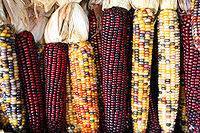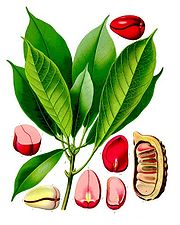
Phlobaphene
Encyclopedia

Mineral acid
A mineral acid is an acid derived from one or more inorganic compounds. A mineral acid is not organic and all mineral acids release hydrogen ions when dissolved in water.-Characteristics:...
s (tanner's red).
The name phlobaphen come from the Greek roots φλoιὀς (phloios) meaning bark
Bark
Bark is the outermost layers of stems and roots of woody plants. Plants with bark include trees, woody vines and shrubs. Bark refers to all the tissues outside of the vascular cambium and is a nontechnical term. It overlays the wood and consists of the inner bark and the outer bark. The inner...
and βαφή (baphe) meaning dye
Dye
A dye is a colored substance that has an affinity to the substrate to which it is being applied. The dye is generally applied in an aqueous solution, and requires a mordant to improve the fastness of the dye on the fiber....
.
As on Dr. Duke's Phytochemical and Ethnobotanical Databases, no biological activities are reported for phlobaphenes. Phlobaphenes from hawthorn
Crataegus
Crataegus , commonly called hawthorn or thornapple, is a large genus of shrubs and trees in the rose family, Rosaceae, native to temperate regions of the Northern Hemisphere in Europe, Asia and North America. The name hawthorn was originally applied to the species native to northern Europe,...
fruits (Fructus Crataegi) may have a specific action on the coronary circulation
Coronary circulation
Coronary circulation is the circulation of blood in the blood vessels of the heart muscle . The vessels that deliver oxygen-rich blood to the myocardium are known as coronary arteries...
.
They are converted into humin
Humin
The chemical compounds in organic soil that do not dissolve when treated with diluted alkali solutions.-References:Singer, Michael J., and Donald N. Munns. Soils An Introduction . Upper Saddle River: Prentice Hall, 2005. isbn: 9780131190191...
s in soils.
Naturally-formed phlobaphenes
Natural phlobaphenes are the common barkBark
Bark is the outermost layers of stems and roots of woody plants. Plants with bark include trees, woody vines and shrubs. Bark refers to all the tissues outside of the vascular cambium and is a nontechnical term. It overlays the wood and consists of the inner bark and the outer bark. The inner...
, pericarp, cob glume and seed coat (testa) pigments. They have not been found in flowers, unless the brown and black pigments in the involucrum of certain compositae are found to be of the phlobaphen type.
In bark, phlobaphenes accumulate in the phellem layer of cork cambium, part of the suberin
Suberin
Suberin is a waxy substance found in higher plants. Suberin is a main constituent of cork, and is named after the Cork Oak, Quercus suber.-Anatomy and physiology:...
mixture.
Occurrences
Many cinchonaCinchona
Cinchona or Quina is a genus of about 38 species in the family Rubiaceae, native to tropical South America. They are large shrubs or small trees growing 5–15 metres in height with evergreen foliage. The leaves are opposite, rounded to lanceolate and 10–40 cm long. The flowers are white, pink...
barks contain a particular tannin, cinchotannic acid
Cinchotannic acid
Cinchotannic acid is a tannin contained in many cinchona barks, which by oxidation rapidly yields a dark-coloured phlobaphene called red cinchonic, cinchono-fulvic acid or cinchona red....
, which by oxidation rapidly yields a dark-coloured phlobaphene called red cinchonic, cinchono-fulvic acid or cinchona red.
They are common in redwood
Redwood
-Trees:Conifers* Family Cupressaceae *** Sequoia sempervirens - coast redwood**** Albino redwood*** Sequoiadendron giganteum - giant sequoia*** Metasequoia glyptostroboides - dawn redwood* Family Pinaceae...
s barks like Sequoia sempervirens or in oak barks where the chief constituent, quercitannic acid, a molecule also present in quercitron
Quercitron
Quercitron is a yellow natural dye obtained from the bark of the Eastern Black Oak , a forest tree indigenous in North America....
, is an unstable substance, having a tendency to give off water to form anhydrides (phlobaphenes), one of which is called oak-red (C28H22O11).
Cuscuta europaea L., the European dodder, is reported to contain 30,000 ppm in the root.

Phlobaphenes can be extracted from the root of the common tormentil (Potentilla erecta) as tormentil red.

Kola nut
Kola Nut is the nut of the kola tree, a genus of trees native to the tropical rainforests of Africa, classified in the family Malvaceae, subfamily Sterculioideae . It is related to the South American genus Theobroma, or cocoa...
(where they are called kola red), chocolate liquor
Chocolate liquor
Chocolate liquor is pure chocolate in its liquid form. Like the cocoa beans from which it is produced, it contains both cocoa solids and cocoa butter in roughly equal proportion....
(called cocoa red) or in the red skins or testa of the peanut. They are also reported in the fruits of the genus Crataegus
Crataegus
Crataegus , commonly called hawthorn or thornapple, is a large genus of shrubs and trees in the rose family, Rosaceae, native to temperate regions of the Northern Hemisphere in Europe, Asia and North America. The name hawthorn was originally applied to the species native to northern Europe,...
(Fructus Crataegi) or can be extracted from hop
Hop (plant)
Humulus, Hop, is a small genus of flowering plants native to temperate regions of the Northern Hemisphere. The female flowers of H. lupulus are known as hops, and are used as a culinary flavoring and stabilizer, especially in the brewing of beer...
flowers.
The chief constituent of kino is kinotannic acid
Kinotannic acid
Kinotannic acid is the chief constituent of the kino gum, of which it contains 70 to 80 per cent. Kino also contains kino red, a phlobaphene produced from kinotannic acid by oxidation. It is closely related to the tannin from catechu; its non-glucosidal nature was established by Bergholz....
, of which it contains 70 to 80 per cent. It also contains kino red, a phlobaphene produced from kinotannic acid by oxidation.
Phlobaphenes are not present in the model plant Arabidopsis thaliana but can be studied as the pigment responsible for the red color in some monocot cereals including wheat
Wheat
Wheat is a cereal grain, originally from the Levant region of the Near East, but now cultivated worldwide. In 2007 world production of wheat was 607 million tons, making it the third most-produced cereal after maize and rice...
, maize
Maize
Maize known in many English-speaking countries as corn or mielie/mealie, is a grain domesticated by indigenous peoples in Mesoamerica in prehistoric times. The leafy stalk produces ears which contain seeds called kernels. Though technically a grain, maize kernels are used in cooking as a vegetable...
or sorghum
Sorghum
Sorghum is a genus of numerous species of grasses, one of which is raised for grain and many of which are used as fodder plants either cultivated or as part of pasture. The plants are cultivated in warmer climates worldwide. Species are native to tropical and subtropical regions of all continents...
.
Biosynthetis
In the maize, they are synthesized in the flavonoids synthetic pathway from polymerisation of flavan-4-olFlavan-4-ol
The flavan-4-ols are flavone-derived alcohols and a family of flavonoids. Flavan-4-ols are colorless precursor compounds that polymerize to form red phlobaphene pigments. They can be found in the sorghum...
s by the expression of maize pericarp color1 (p1) gene which encodes an R2R3 myb-like transcriptional activator of the A1 gene encoding for the dihydroflavonol 4-reductase (reducing dihydroflavonols into flavan-4-ols) while another gene (Suppressor of Pericarp Pigmentation 1 or SPP1) acts as a suppressor.
In the sorghum, the corresponding yellow seed 1 gene (y1) also encodes a R2R3 type of Myb domain protein that regulates the expression of chalcone synthase
Chalcone synthase
Chalcone synthases are a family of polyketide synthase enzymes associated with the production of chalcones, a class of organic compounds found mainly in plants as natural defense mechanisms and as synthetic intermediates, for example in the production of pigments...
, chalcone isomerase
Chalcone isomerase
In enzymology, a chalcone isomerase is an enzyme that catalyzes the chemical reactionHence, this enzyme has one substrate, a chalcone, and one product, a flavanone....
and dihydroflavonol reductase genes required for the biosynthesis of 3-deoxyflavonoids.
Chemically formed phlobaphenes
It is a dark-colored resin-like substance made of water insoluble, alcohol soluble polymers.Phlobaphens can be formed under action of acids or heating of condensed tannins or of the fraction of tannins called phlobatannins. Water containing soda can be used for the conversion of hop
Hop (plant)
Humulus, Hop, is a small genus of flowering plants native to temperate regions of the Northern Hemisphere. The female flowers of H. lupulus are known as hops, and are used as a culinary flavoring and stabilizer, especially in the brewing of beer...
tannins into phlobaphens. When heated with hydro-chloric acid, tannins in cocoa solids
Cocoa solids
Cocoa solids are the low-fat component of chocolate. When sold as an end product, it may also be called cocoa powder, cocoa, and cacao....
yield a glucose and a phlobaphene.
Ordinary or warm soluble quebracho (also known as insoluble Quebracho) is the natural extract obtained directly from the quebracho wood. This type of extract is rich in condensed tannins of natural high molecular weight (phlobaphenes), which are not easily soluble. Its use is therefore limited to small additions during sole leather tannage carried out in hot liquors (temperature above 35°C) to improve the yield and the water-proofness of the leather. The cold soluble extracts are obtained by subjecting the ordinary extract to a sulphiting process
Sulfite process
The sulfite process produces wood pulp which is almost pure cellulose fibers by using various salts of sulfurous acid to extract the lignin from wood chips in large pressure vessels called digesters. The salts used in the pulping process are either sulfites , or bisulfites , depending on the pH...
which transforms the phlobaphenes into completely soluble tannins. The cold soluble quebracho extracts are the most universally known and used types. The main properties of these extracts are: a very rapid penetration, a high tannin content and a relatively low percentage of non-tannins. The rather low acid and medium salt content characterise them as mild tanning extracts (low astringency).
Phlobaphenes formation (tannins condensation and precipitation) from can be minimized in using strong nucleophiles, such as phloroglucinol
Phloroglucinol
Phloroglucinol is a benzenetriol. It is an organic compound that is used in the synthesis of pharmaceuticals and explosives. This molecule exists in two forms, or tautomers, 1,3,5-trihydroxybenzene, which has phenol-like, and 1,3,5-cyclohexanetrione , which has ketone-like character. These two...
, m-phenylenediamine
M-Phenylenediamine
m-Phenylenediamine, also called 1,3-diaminobenzene, is an organic compound with the formula C6H42. It is an isomer of o-phenylenediamine and p-phenylenediamine. It is a colourless solid.-Production:...
and urea
Urea
Urea or carbamide is an organic compound with the chemical formula CO2. The molecule has two —NH2 groups joined by a carbonyl functional group....
, during pine tannins extraction.
The use of synthetic tannin neradol D can help solubilize phlobaphen in tanning solutions.

